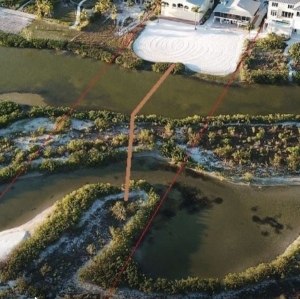The battle over who owns the land designated as a Critical Wildlife Area on Fort Myers Beach continues between south end property owners Kurt Kroemer and Eddie Rood and the State of Florida Board of Trustees.
In early June, the State submitted a Motion for Summary Judgement, in an attempt to dismiss the case using undisputed facts surrounding the ownership. Within the State’s Summary Judgement motion was a document titled “The Morphological Evolution of Little Estero Island” which describes how Little Estero Island evolved and the process for which it grew over the last 40 years to finally settle in the back of Kroemer & Rood’s lots, over a mile from the island’s beginning.
Last week, Kroemer and Rood submitted their response to the Summary Judgement motion. In all the document submitted to the court by the homeowners was 360 pages. The reason we are here is because Rood and Kroemer believe they should be allowed to build a walkover to the beach from their homes and the CWA is now directly behind those homes, blocking their access directly to the beach. The town of Fort Myers Beach denied the homeowners a special exception to build the walkover and now they are attempting to prove they own the land behind their homes. Even if it’s proven they own the land they would still need the special exception. They may have the votes to get it approved in November when the new town council takes office.
Of the 33 facts listed in the State’s motion, Kroemer and Rood disputed 16 of them. Their response is subject to two different ownership issues. They dispute the State’s ownership of the land as well as the State’s ownership claim to the lagoons or ponds directly adjacent to their property.
The response attacks the formation of Little Estero Island in a number of ways. The first challenge is if the State correctly set up notice of ownership of Little Estero Island back in 1980. Plaintiffs’ assert that the Notice not only has no legal effect whatsoever, but additionally, TIFF (the state) is not granted any authority under the Florida Constitution or Florida Statutes to record documents claiming ownership. The Notice is not notarized, has no witnesses, does not include a surveyed description of the lands claimed, has no grantor or grantee, no consideration, and does not reference by what authority the claim is being made.
The majority of Kroemer and Rood’s response centers around a very technical discussion of how barrier island sand moves near and around inlets. With the help of a coastal engineer and other 3rd party studies, the response details how sand moves in and out of outlets such as Big Carlos Pass. It states sand movement is structured and follows common patterns. The movement of Little Estero Island is nothing more than common sand bars and shoals moving with the tides of the Gulf of Mexico. Both sides agree and highlight that Little Estero Island “disintegrated” around 1983. How and if it came back is a major focus of their dispute. The document states: It is important to note here, however, that there is no such thing as an island “regrowing” for the purposes of establishing ownership to accreted lands.
The contention is that if the island grew back, “is it still an island surrounded by waters?”, “where did the sand come from?” and “who owns it?”
The landowners also disagree with the concept of the disputed land actually being Little Estero Island. They contend that the accreted sand comes from a different direction and a different source than the state story. The State claims the land is Little Estero Island that came down from the North, while Kroemer and Rood contend aerial photos through time show the sand coming from the direction of Big Carlos Pass, in a completely opposite direction from the States claims.
The response also challenges the State’s ownership with a separate second issue, that being who owns the ponds. In order for the State to own the land under a water body, the water must be “Navigable” and/or “Tidal.” Tidal studies using instruments by both sides quickly proved the pond is no longer tidal. The test for Navigability lies with the definition if boating activities are actually used for commerce. Rood and Kroemer state that both requirements fail in this case.
The hearing on the outcome of this summary judgment motion is expected to happen in September. Should the State’s facts be accepted, then this dispute would be over and the CWA boarders remain. However, if Kroemer and Rood’ objections are strong enough to send this case to Lee County Court, then the continued existence of the CWA might be at risk pending the final decision of this Quiet Title lawsuit.
Read the entire 360 page document filed by Rood and Kroemer HERE.


Comments are closed.